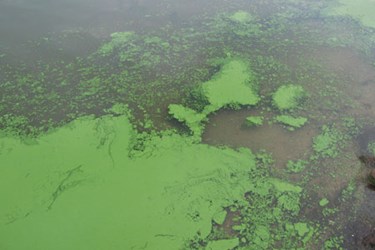New Drinking Water Regulations Sought For Algal Toxins
By
Kevin Westerling
@KevinOnWater

Excess nutrients, blue-green algae (cyanobacteria), and cyanotoxins have long been a problem for wastewater treatment plants (WWTPs) — many states regulate nutrient levels in discharged water — but now drinking water plants are being eyed for regulation as well.
In response to this summer’s ban on drinking water in Toledo, OH, legislators in that state — Reps. Mike Sheehy (D-Oregon) and John Patterson (D-Jefferson) — introduced a bill on Sept. 22 that would require water treatment plants (WTPs) to test for microcystin, the most widespread and dangerous cyanotoxin, and notify public health officials if levels exceed what is considered safe. The existing benchmark is no more than 1 part per billion, established by the World Health Organization (WHO).
On Sept. 10, three federal lawmakers — Rep. Marcy Kaptur (D-Toledo) and Sens. Sherrod Brown (D-Ohio) and Rob Portman (R-Ohio) — introduced a bipartisan bill aimed at fast-tracking a national drinking water standard for microcystin. The Safe and Secure Drinking Water Act calls upon the U.S. EPA to publish a health advisory on microcystin within 90 days and to report on a “safe” consumption level, as well as suitable treatment and testing, within 120 days.
Typically, the process for new drinking water regulations is a long one. Preliminary regulatory determinations come from the EPA's Contaminant Candidate List (CCL) or from data pursuant to the Unregulated Contaminant Monitoring Rule (UCMR). From there, final regulatory determinations are made and a rule is proposed, potentially finalized, and made part of the National Primary Drinking Water Regulations (NPDWRs).
The Toledo crisis, wherein 400,000 people were without drinking water for two days, could expedite that process.
Cause And Treatment
Harmful algal blooms (HABs) develop when excess nutrients (phosphorus and nitrogen) make their way into waterways, often via agricultural runoff since animal waste and fertilizer are main sources. The HABs kill off plants and animals by consuming too much dissolved oxygen, prompting regulations and variety of nutrient management schemes to limit point source (wastewater treatment plant) and non-point source (or runoff) wastewater discharges. HABs also create toxins that threaten humans — namely microcystin, which is linked to breathing problems, skin reactions, liver damage, and even death.
While WWTPs are more equipped to handle nutrients (and would have higher regulatory limits), WTPs with microcystin in their source water are facing a new, potentially expensive challenge. Some Ohio plants are voluntarily testing for and treating the toxin, and have reported on the cost.
According to The Toledo Blade, Carroll Township spent about $225,000 on ozone generators and related upgrades to pretreat and oxidize any organics and eliminate microcystin. The WTP in Oregon, OH, relied on a more traditional solution, activated carbon, but saw its chemical expenses increase by $3,000 per month during the algae season. There are also costs for additional staffing and O&M, in addition to those related to testing. Therefore, if the bills proposed this month turn into law, funding may become an issue for municipalities. Of course, there is also a serious cost associated with non-action.
My Take
The state bill proposed in the Ohio legislature seems to have potential due to the shared experience and emotion tied to the Toledo incident, the feasibility of implementation (only testing at this point), and the prevalence of blue-green algae in the state.
The federal bill seeks to provide similar safeguards nationwide — well-meaning, for sure — but source waters and nutrient pollution are different everywhere, so it may be best to deal with the microcystin issue locally. On the wastewater side, for example, total maximum daily loads (TMDLs) are determined for particular watersheds and dischargers are then regulated accordingly.
How a national standard would be carried out can certainly be ironed out, but the federal proposals also dictate a relatively short timeframe (90 days/120 days) to come back with actionable intelligence. Whether it is unrealistic from a research standpoint or an agency standpoint, it’s simply not a pace the EPA is accustomed to.
We shall discover the fate of both the state and federal bills in November, when lawmakers in Ohio and Washington, D.C. give their take on the necessity, urgency, and feasibility of implementing these proposed standards at WTPs.
What’s your take? Share your thoughts in the comments section below…
Image credit: "Algae Bloom," eutrophication&hypoxia © 2006, used under an Attribution 2.0 Generic license: https://creativecommons.org/licenses/by/2.0/
Copyright © 1996 - 2014, VertMarkets, Inc. All rights reserved. To subscribe or visit go to: http://www.wateronline.com
http://www.wateronline.com/doc/legislators-seek-new-drinking-water-regulations-for-algal-toxins-0001